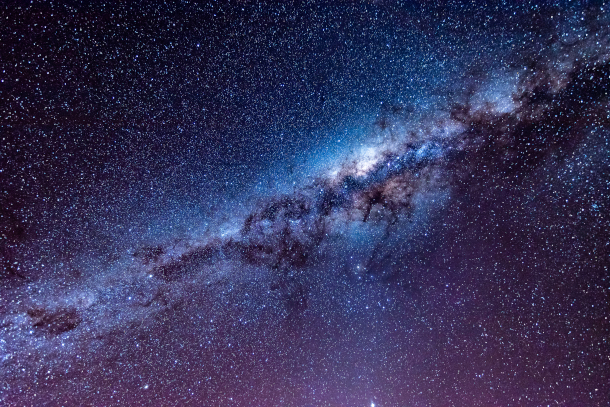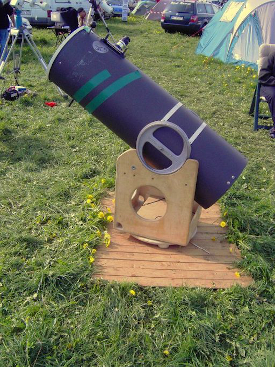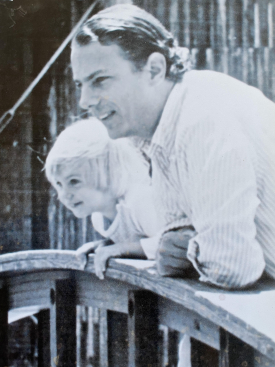“How to Love the Stars”
Air Date: Week of July 8, 2022

Jennifer Junghans observes that the stars are “light memories from the same stars the first hominids looked up and saw.” (Photo: Graham Holtshausen on Unsplash)
You don't need a $10 billion telescope to take in the wonder of the universe. You can make a simple one yourself, or even just look up with your own two eyes. And for writer Jennifer Junghans, that connection to the stars also represents a connection to her dad.
Transcript
BASCOMB: Well, you don't need a $10 billion telescope to take in the wonder of the universe. You can make a simple one yourself, or even just look up with your own two eyes. And for writer Jennifer Junghans, that connection to the stars is also a connection to her dad.
JUNGHANS: It’s a muscle memory now, to look up and search the night sky. Even if just for a moment to return to the time when I was young and my dad was too, him bursting with enthusiasm to unlock for my sister and me all the magic that lived in those stars.
He’d fiddle with the Dobsonian telescope he built, making endless minute adjustments. At last, he’d usher us to peer through the eyepiece at the magnified stars before Earth rotated them out of view.

A homemade Dobsonian telescope (Photo: ECeDee, Wikimedia Commons public domain)
He’d name the stars and point upward connecting the dots for us into constellations that I could never quite make out. Always with an urgency, as though his work as a father wouldn’t be done until he taught us how to love the stars.
I think he wanted us to know how to lose ourselves in the mysteries of the twinkling sky. To believe in possibilities beyond what we know. To accept with certainty, we’re supposed to be here even though we don’t yet understand how we fit into the grand scheme of the universe.
[MUSIC: Blue Dot Sessions, “The Onyx”]
Beyond the dazzling beauty, I fell in love with the constancy of the night sky. All the loss in our lives, the dreams that never came to be, the loneliness … I forget it all when I stargaze and bathe in the galaxy.
The signatures of light we see are the museums of these gaseous, fiery balls that have burned and pulsed for millions sometimes billions of years. They’re light memories from the same stars the first hominids looked up and saw. The same ones that lit the sky when dinosaurs roamed.

A young Jennifer Junghans with her dad, who taught her “how to love the stars” with a homemade telescope. (Photo: Courtesy of Jennifer Junghans)
The time continuum is almost unfathomable, this stitching together of all who came eons before us and all who will come after, bound in the accumulated history of the stars. They are the universal witnesses. And in this way, nothing is forgotten and everything still exists.
[MUSIC: Blue Dot Sessions, “The Onyx”]
I find great comfort in that as my dad’s memories dim. He’s transitioning like a giant star about to expire, exploding into a luminous, spectacular supernova. In the same way, his energy will outlast his physical body. I wonder where it will go? Could it disperse into the universe and form a new star that burns for another billion years?
It’s a legacy I think my dad would love. And it’s the one I’ll hold on to. Believing that when I look up into the night sky, it’s my dad’s light I’ll see.
[MUSIC: Blue Dot Sessions, “The Onyx”]
BASCOMB: That's writer Jennifer Junghans with her essay, "How to Love the Stars."
Links
Watch: Step-by-step making of a Dobsonian telescope, with amateur astronomer John Dobson
Living on Earth wants to hear from you!
Living on Earth
62 Calef Highway, Suite 212
Lee, NH 03861
Telephone: 617-287-4121
E-mail: comments@loe.org
Newsletter [Click here]
Donate to Living on Earth!
Living on Earth is an independent media program and relies entirely on contributions from listeners and institutions supporting public service. Please donate now to preserve an independent environmental voice.
NewsletterLiving on Earth offers a weekly delivery of the show's rundown to your mailbox. Sign up for our newsletter today!
 Sailors For The Sea: Be the change you want to sea.
Sailors For The Sea: Be the change you want to sea.
 The Grantham Foundation for the Protection of the Environment: Committed to protecting and improving the health of the global environment.
The Grantham Foundation for the Protection of the Environment: Committed to protecting and improving the health of the global environment.
 Contribute to Living on Earth and receive, as our gift to you, an archival print of one of Mark Seth Lender's extraordinary wildlife photographs. Follow the link to see Mark's current collection of photographs.
Contribute to Living on Earth and receive, as our gift to you, an archival print of one of Mark Seth Lender's extraordinary wildlife photographs. Follow the link to see Mark's current collection of photographs.
 Buy a signed copy of Mark Seth Lender's book Smeagull the Seagull & support Living on Earth
Buy a signed copy of Mark Seth Lender's book Smeagull the Seagull & support Living on Earth

